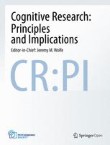Registered Reports are intended to strengthen the reliability and validity of the results in our science. Submission is via a two-stage process. Authors submit a proposed study. If it passes initial review, Cognitive Research: Principles and Implications will commit to publishing the results, regardless of the outcome, assuming that the methods and analysis in the final study conforms to the initially approved proposal.
Find out more about this publication format and read our author and reviewer guidelines for additional information.
There must be a Significance Statement, of no more than 250 words. This section should immediately follow the abstract (word limit also 250 words). Recall that CRPI is focused on “use-inspired basic research”, fundamental research that grows from hypotheses about real-world problems. The significance statement should make clear how your work was derived from an issue in the world. Ideally, the significance statement should be understandable by a broad audience and not only by specialists in our field. If you have questions about this aspect of your manuscript, send an email to the Editor, Sarah Creem-Regehr.
In 2017, the Psychonomic Society signed on to the Open Science Initiative’s Level 1 Transparency and Openness Guidelines. All authors are required to respond to the questions below, and in addition, all submitted manuscripts must include an Open Practices Statement immediately prior to the References section of the paper. The statement must specify (1) whether data and/or materials are available, and if so, where (as per Level 1 TOP guidelines, URLs are required to have a persistent identifier); and (2) whether any experiments were preregistered, and if so, which.
Manuscripts are to adhere to the conventions described in the Publication Manual of the American Psychological Association (APA 7th ed). Authors are encouraged to use color in figures. There is no charge for color since Cognitive Research: Principles and Implications is an electronic/online journal. Submissions will be subject to rigorous peer review, in keeping with the standards of the Psychonomic Society, the sponsor of the journal. We will strive for rapid and broad-minded review. We expect clearly described, well executed studies. We will not insist on adherence to any specific theoretical position but we expect that studies will advance our scientific understanding.
If you are a member of the Psychonomic Society and wish to publish in this journal, there is a discount on the regular Article Processing Charge (APC). Please contact the Psychonomic Society for more information.
If you would like to enquire about the suitability of a study for consideration, please email a pre-submission enquiry to the Editors at sarah.creem@psych.utah.edu.
